Hot Research Topics 2012
Hot Topics Home
2015 | 2014 | 2013 | 2012 | 2011
2010 | 2009 | 2008 | 2007 | 2006
Agricultural Research Service Information Staff's Image Gallery - a complimentary source of high quality digital photographs
Animal Health
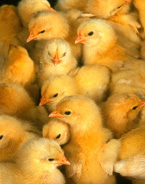 Strategies That Work: Alternatives to Antibiotics in Animal Health
Strategies That Work: Alternatives to Antibiotics in Animal Health
In the early 1940s, the first antibiotic-penicillin-was used successfully to treat bacterial infections and to save thousands of lives, including those of wounded World War II soldiers. Today, antibiotics, which target microorganisms like bacteria, fungi, and parasites, are essential for human and animal health. They continue to save lives as well as increase animal production and efficiency.
However, exploration of alternative strategies to mitigate the use of antibiotics is needed in view of growing concerns about antibiotic resistance to certain strains of bacteria and increasing restrictions on their prudent use in animals. Some of the latest scientific breakthroughs and technologies, which provide new options and alternative strategies for enhancing production and improving animal health and well-being, will be presented at an international symposium, "Alternatives to Antibiotics: Challenges and Solutions in Animal Production," September 25-28, 2012, at the headquarters of the World Organization for Animal Health (known as "OIE") in Paris, France.
Agricultural Research magazine, May 2012 Complete Article
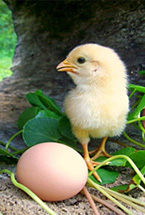 Cracking Down on Poultry Disease with Egg Yolk
Cracking Down on Poultry Disease with Egg Yolk
It's not mother's milk, but egg yolk may be the closest remedy for boosting the immune system of newly hatched chickens against infectious diseases such as coccidiosis.
A major disease of chickens, coccidiosis is caused by intestinal parasites-single-celled protozoans in the genus Eimeria. Disease-affected birds are unable to absorb feed or gain weight, costing the poultry industry more than $600 million annually in the United States and $3 billion worldwide.
Scientists at the Agricultural Research Service Henry A. Wallace Beltsville [Maryland] Agricultural Research Center (BARC) and collaborators from different universities and the Mexican company IASA (Investigac?on Aplicada, S.A.) have developed a novel, antibiotic-free method that uses hyperimmune egg yolk antibodies to control intestinal poultry diseases.
Agricultural Research magazine, July 2012 Complete Article
Biocontrol Agents
 Roundworms (and Their Bacterial Buddies) Rub Out Pests
Roundworms (and Their Bacterial Buddies) Rub Out Pests
Roundworms, microscopic wormlike organisms also known as "nematodes," can be friend, foe, or something in between. Some species are parasitic, dependent on hosts-plant, animal, insect, or human-to survive. Others are stealthy predators, prowling soils and other hunting grounds for bacteria, fungi, and other microbial prey-or sometimes ambushing them.
Lynn Carta and colleagues at the Agricultural Research Service's Nematology Laboratory in Beltsville, Maryland, are among the world's foremost authorities on nematodes and have developed sophisticated tools and techniques for studying their morphological, biochemical, and genetic features in unprecedented detail.
Agricultural Research magazine, August 2012 Complete Article
Crop Diversity
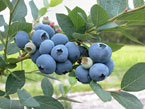 Pink Lemonade, Razz, and More! Wonderful Blueberries From ARS to You: New Blueberry Releases
Pink Lemonade, Razz, and More! Wonderful Blueberries From ARS to You: New Blueberry Releases
Dr. Mark Ehlenfeldt, Blueberry Research Plant Geneticist, Marucci Center for Blueberry and Cranberry Research & Extension, Genetic Improvement of Fruits and Vegetables Laboratory has released four new blueberry cultivars, Pink Lemonade, Razz, Sweetheart and Clara's Choice.
Agricultural Research magazine, September 2012 Complete Article
 Fruits and Veggies for Now and in the Future: Potatoes, Pepppers, Strawberries and Raspberries.
Fruits and Veggies for Now and in the Future: Potatoes, Pepppers, Strawberries and Raspberries.
Fruits and vegetables are important parts of a balanced diet, and making sure consumers have an abundant supply of them is part of the Agricultural Research Service's mandate.
Genetic improvements in fruits and vegetables are essential to meet the ever-changing needs of growers, processors, and consumers. Scientists in ARS laboratories around the country strive to meet those needs.
Agricultural Research magazine, October 2012 Complete Article
Historical Perspective
 150 Years of Making History: USDA's 150th Anniversary May 15, 2012
150 Years of Making History: USDA's 150th Anniversary May 15, 2012
USDA's 150th anniversary is in 2012. Abraham Lincoln signed a bill in 1862 to create the Department. Since then, USDA scientists have been busy solving problems and creating technologies and products for people here and around the world.
Agricultural Research magazine, May/June 2012 Complete Article
Honey Bees
 Colony Collapse Disorder: An Incomplete Puzzle
Colony Collapse Disorder: An Incomplete Puzzle
When it comes to solving the puzzling syndrome known as "colony collapse disorder" (CCD), which has been attacking honey bee colonies since 2006, the best that can be said is that there is good news and bad news. The good news is that the rate of honey bee losses seems to have leveled off rather than continuing to increase. The bad news is that the cause or causes of CCD remain unclear.
In the United States, the problem surfaced in October 2006, when an increasing number of beekeepers began reporting losses of 30 to 90 percent of the hives in their apiaries with no apparent cause. The defining characteristic of CCD is the disappearance of most, if not all, of the adult honey bees in a colony, leaving behind honey and brood but no dead bee bodies. This definition has recently been revised to include low levels of Varroa mite and other pathogens, such as Nosema, as probable contributing factors.
Agricultural Research magazine, July 2012 Complete Article
Insect Pests
 Barcoding Insects To Control Them
Barcoding Insects To Control Them
Mention barcodes and it often brings to mind the sales tags and scanners found in supermarkets and other stores. But Agricultural Research Service scientists are using "DNA barcodes" in their search for ways to control and monitor insects that pose the greatest threats to crops as diverse as wheat, barley, and potatoes.
In DNA barcoding, scientists sequence a designated part of an organism's genome and produce a barcode from it for a systematic comparison with the sequenced DNA of other closely related species. DNA barcodes are being developed on a wide range of plants and animals as part of a global effort to catalog the diversity of life on Earth.
Agricultural Research magazine, April 2012 Complete Article
Nutrition
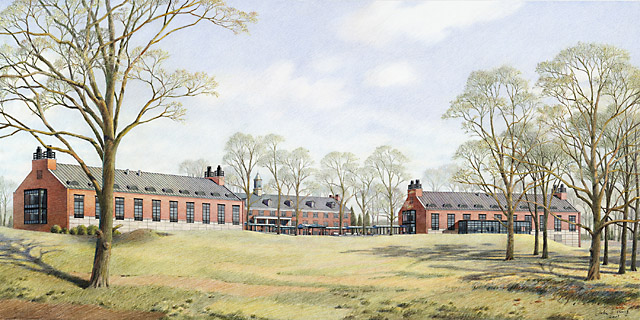 Monitoring Best Practices for Food Analysis: The First Step - Monitoring What We Eat
Monitoring Best Practices for Food Analysis: The First Step - Monitoring What We Eat
Nestled in the Maryland suburbs outside northeast Washington, D.C., is arguably the world's largest and most diversified agricultural research complex-the Henry A. Wallace Beltsville Agricultural Research Center (BARC). Among its 7,000 acres of fields, farmland, and science buildings is the Beltsville Human Nutrition Research Center (BHNRC)-the oldest and most comprehensive of six human nutrition research centers within the Agricultural Research Service.
Agricultural Research magazine, March 2012 Complete Article
 Monitoring Food-Supply Nutrients: The Second Step-Conservators of the National Nutrient Database
Monitoring Food-Supply Nutrients: The Second Step-Conservators of the National Nutrient Database
For more than 115 years, the U.S. Department of Agriculture has provided data on the nutrient composition of foods in the American diet. Over time, a series of USDA institutions responsible for providing this data evolved, and today the data comes from the Beltsville Human Nutrition Research Center (BHNRC), part of USDA's Agricultural Research Service.
Agricultural Research magazine, March 2012 Complete Article
 Monitoring the U.S. Population's Diet: The Third Step-The National "What We Eat in America" Survey
Monitoring the U.S. Population's Diet: The Third Step-The National "What We Eat in America" Survey
In 2010, landmark health legislation-the Affordable Care Act-was passed, leading to a national strategy crossing both private and public sectors and led by the National Prevention, Health Promotion, and Public Health Council of the Surgeon General. The plan is called the "National Prevention Strategy."
Agricultural Research magazine, March 2012 Complete Article
 Nutrient Data in Time for the New Year
Nutrient Data in Time for the New Year
Federal rules published in 2010 require specific meat and poultry products to carry new nutrition information starting January 2, 2012. USDA's Food Safety and Inspection Service (FSIS) announced that the new rules will make important nutrition information readily available to consumers on 40 of the most popular cuts of meat and poultry. Two timely data sets provided by the Agricultural Research Service's Nutrient Data Laboratory (NDL) in Beltsville, Maryland, are being used by the beef and pork industries to provide the new Nutrition Facts labels for their products.
Agricultural Research magazine, January 2012 Complete Article
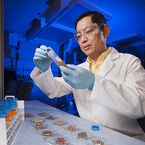 Digital Detectives Decipher Ingredients
Digital Detectives Decipher Ingredients
Television shows featuring crime scene investigators have been keeping viewers intrigued for years. But the Agricultural Research Service's intriguing "food composition investigators" are just as innovative at deciphering truth from fiction relating to ingredients of plant-based foods and dietary supplements. The researchers are at the ARS Food Composition and Methods Development Laboratory, which is headed by research leader James Harnly. The laboratory is part of the Beltsville [Maryland] Human Nutrition Research Center (BHNRC).
Agricultural Research magazine, April 2012 Complete Article
Water Quality
 A New Way To Map Drought and Water Use Worldwide
A New Way To Map Drought and Water Use Worldwide
Every month, the National Oceanic and Atmospheric Administration's (NOAA) Center for Climate Prediction has a drought briefing by teleconference to identify the latest drought areas in North America.
ARS scientists Martha Anderson and Bill Kustas are hoping that in a year or so, data from their computer model/satellite package will give evapotranspiration (ET) maps a seat at that briefing. With funding from NOAA and the National Aeronautics and Space Administration (NASA), they have developed a modeling system that NOAA will use to generate ET estimates over the continental United States.
Agricultural Research magazine, Feburary 2012 Complete Article
